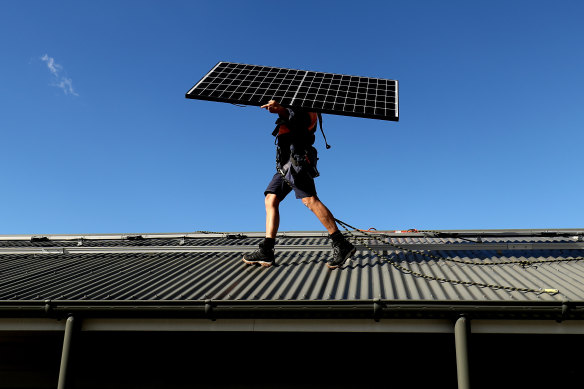This was published 1 year ago
Tonnes and tonnes of old solar panels with nowhere to go
Australia is on track to generate at least 50,000 tonnes of solar waste a year as the number of panels being retired surges faster than predicted, prompting calls to boost limited recycling facilities.
And as governments race against the clock, this masthead can reveal that a Victorian scheme set up in 2022 to find innovative solutions to the problem is yet to find a suitable candidate.

Australia’s early take-up of solar has created a new challenge in recycling panels as they reach their end of life.Credit: Bloomberg
Findings published by the Australian Centre for Advanced Photovoltaics, which is led by UNSW Sydney, project the volume of panels removed from use will soar over the coming decade – creating a massive recycling challenge. It proposes a 12-year road map to creating a circular economy across the sector.
Nationally, the centre forecasts there will be 50,872 tonnes of solar waste in 2024 – and that could surge to to 91,165 tonnes by 2035.
“The volume of end-of-life solar panels is expected to grow rapidly in New South Wales, Victoria and Queensland, with calls for immediate action by the industry to prevent landfilling,” the report says.
Queensland’s waste is expected to lift from 15,390 tonnes this year to 27,053 tonnes by 2030. Over the same period, New South Wales will rise from 13,463 tonnes to 26,389 tonnes and Victoria from 9570 tonnes to 17,323 tonnes.
By the end of the decade, more than 80 per cent of this waste will come from small-scale systems due to Australia’s early take-up of rooftop solar.
Dr Rong Deng, one of the authors of the report, said more solar panels were heading to waste than expected because previous forecasts had used old or wrong methods.
“Normally, we think solar panels have a 25-year lifetime,” she said.
“But in Australia, we observed many early retirements, that means people tend to replace them after three, five or seven years … that’s why we bring the crisis, if you want to call it a crisis, a few years earlier.”
Deng said for rooftop solar, owners were likely to retire systems earlier than expected because new panels were cheaper and more efficient.
“The technical lifetime is 25 to 30 years, but we’re looking at a practice lifetime of 10 to 15 years,” she said.
The report found the cost of recycling solar panels ranged between $500 and $1000 per tonne, including transportation but not accounting for the money raised selling materials.
“The economics are challenging but as a very early-stage technology, we think there’s improvement in the technology itself that will improve the economics,” Deng said.
Victoria and South Australia are the only states to ban solar panels – which are classified as e-waste – from going to landfill. However, the number of working recycling facilities is still limited.
Specialists can achieve up to 90 per cent material recovery, according to Solar Victoria. Lotus Energy, based in Melbourne, has opened a facility that it says is the first in Australia to reuse 100 per cent of its recovered materials.
There are also concerns that panels will be stockpiled until the industry is expanded, a practice governments have tried to avoid so as to reduce safety risks and free up valuable land.
In September 2022, the Victorian government announced a $10 million “solar waste challenge” under which the state’s own start-up fund – Breakthrough Victoria – would seek to invest in innovative solutions to reduce solar waste.
But a Breakthrough Victoria spokeswoman said it had assessed several companies for investment but no funding had been approved. Applications remain open.
She said more than 600,000 solar systems had been installed in Victoria since 2001 and there was an “emerging problem to address when those solar panels are replaced”.
Libertarian MP David Limbrick raised the issue of solar waste in Victorian parliament in 2019 and said panels were being stored in sheds while agencies sought solutions to the problem.
“The Victorian government thought that one day they would be viable for recycling but that day has arrived, and they are still not economic,” he said.
Victoria has a small number of facilities able to recycle solar panels but a state government spokeswoman said research in new technology was being encouraged as the market grew.
“Comprehensive recycling of solar photovoltaic panels is a significant challenge and opportunity for resource recovery globally,” she said.
A $150,000 grant to Deakin University’s Institute for Frontier Materials funded a successful project to extract silicon from old panels, converting it into a “nano material” worth more than $45,000 per kilogram.
The Victorian government is working with the Commonwealth on setting up a national stewardship that would work with industry to improve the recovery and reuse of solar panels.
State opposition energy spokesman David Davis said the issue of solar waste had been clear years ago, but Victoria still had limited options for recycling.
“There is a cascade of end-of-life solar panels that must be dealt with to avoid dumping,” he said.
Get to the heart of what’s happening with climate change and the environment. Sign up for our fortnightly Environment newsletter.